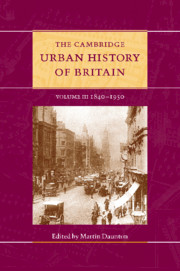Book contents
- Frontmatter
- 1 Introduction
- Part I Circulation
- Part II Governance
- Part III Construction
- Part IV Getting and spending
- 18 Industrialisation and the city economy
- 19 The urban labour market
- 20 Urban fertility and mortality patterns
- 21 The middle class
- 22 Towns and consumerism
- 23 Playing and praying
- Part V Images
- Select bibliography
- Index
- Plates 1-7
- Plates 8-14
- Plates 15-20
- Plates 21-27
- Plates 28-34
- Plates 35-41
- Plates 42-48>
- Plates 49-53
- References
19 - The urban labour market
from Part IV - Getting and spending
Published online by Cambridge University Press: 28 March 2008
- Frontmatter
- 1 Introduction
- Part I Circulation
- Part II Governance
- Part III Construction
- Part IV Getting and spending
- 18 Industrialisation and the city economy
- 19 The urban labour market
- 20 Urban fertility and mortality patterns
- 21 The middle class
- 22 Towns and consumerism
- 23 Playing and praying
- Part V Images
- Select bibliography
- Index
- Plates 1-7
- Plates 8-14
- Plates 15-20
- Plates 21-27
- Plates 28-34
- Plates 35-41
- Plates 42-48>
- Plates 49-53
- References
Summary
Towns are often presented as market centres, but mainly as places for the buying and selling of goods, or for financial transactions. However, the role of towns, and particularly of large towns, is closely connected to the operation of markets for labour. In this chapter, labour is defined in a specific way. Traditionally, the realm of labour has been defined both narrowly, in that ‘labour’ has been equated with the working class, and often with male manual workers, but also broadly, in that labour history concerns itself with working life as a whole, and with associated leisure activities. Here the concern is with markets for labour, which means a very specific aspect of people’s lives: the processes through which individuals acquired an occupation, with its associated status and skills, and acquired particular jobs; or looked at the other way, how employers acquired a workforce and filled particular positions. These processes had not only economic significance, influencing the development of civil society in many towns. They shaped people’s lives, the communal life of individual towns and the ways in which towns were connected into an urban system.
‘Labour’ is a particularly complex commodity: a labour supply is not manufactured but bred, and takes years to mature; a labour supply can only be hired, never bought, and once hired must still be encouraged or coerced to undertake useful work. It is incredibly differentiated, and this differentiation grows as an economy develops. All these characteristics interact to create large externalities, meaning non-price mechanisms through which one economic factor affects another, and the economics of towns and cities are all about externalities.
Keywords
- Type
- Chapter
- Information
- The Cambridge Urban History of Britain , pp. 593 - 628Publisher: Cambridge University PressPrint publication year: 2001

